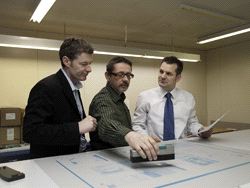Prepress
dfmedia Boosts Efficiency and Print Quality With the New KODAK TRILLIAN SP Thermal Plate

Tuesday 16. November 2010 - Media company reaps the benefits of becoming a pilot sheet-fed offset user of Kodaks innovative plate technology
dfmedia, a media company operating in the print, publishing and online sectors, has improved efficiency, print quality and its ecological footprint following its beta testing of the new KODAK TRILLIAN SP Thermal Plate. The 165-strong company has been trialling the innovative plate in its sheet-fed offset operation at its headquarters in Flawil, North-East Switzerland. dfmedias sheet-fed offset production set-up comprises a newly installed ten-colour press, as well as a five-colour press offering 3B format, and another five-colour press with a sheet format of 370 x 520 mm. The companys commercial production portfolio includes books, periodicals, advertising, brochures, covers and business materials.
dfmedia chose to introduce the new TRILLIAN SP Thermal Plate because of its robustness, process stability and chemical consumption. During the project, which included the installation of a new plate processor, the company benefited from consulting services and on-site support from Kodaks commercial partner, OFS Group: “This new innovation from Kodak involved switching from a positive to a negative plate, which requires no pre-heating, allows rapid imaging in the CTP system, and can be processed significantly faster than other plate products,” explains José Torregrosa, Head of Pre-print Operations. Every year, his department produces approximately 30,000 plates ready for printing, more than 80% of which are for the 3B format presses.
New plate represents multi-faceted progress
The KODAK TRILLIAN SP Thermal Plate can achieve runs of up to 500,000 impressions without postbaking, and can be used for runs of up to one million with postbaking. Although the runs required by dfmedia – which are generally between 8,000 to 15,000 copies – rarely demand this type of performance, the new plates overall robustness, excellent resistance to mechanical influences and chemicals eg alcohol substitute materials and cleaning agents, as well as its suitability for printing with UV-curing inks, bring welcome advantages for dfmedia.
In addition, the TRILLIAN SP Plates high resolution and stability during digital imaging and processing are helping the company achieve finer and more uniform screening: “Before we started working with the new plate, we used an AM screen of 60/cm for printing on uncoated papers and a screen ruling of 80/cm or a 20 µm FM screen for coated papers,” explains Torregrosa. “Were also looking into using a finer screen for uncoated papers. Our aim is to be able to work with a uniform hybrid screen.”
Significant environmental and cost benefits
dfmedia has realized its aim of using the TRILLIAN SP Plate to significantly reduce chemical consumption during plate processing: “We are making very significant savings in terms of developer. As there is no oxidation of the developer, we only need to regenerate normal developer carryover. This means we can get by with a regeneration rate of 30 to 40 millilitres per square metre,” explains Torregrosa, who has 20 years professional experience.
In addition, the OFS Groups technical experts have switched the rinsing section of the plate processing system to water recirculation, greatly reducing fresh water consumption: “We are achieving ecological benefits and, at the same time, enormous cost savings,” adds Torregrosa. “It is already paying off, even more so when we extrapolate the benefits over the entire year.”
dfmedia replaces the developer for the KODAK TRILLIAN SP Thermal Plate after a throughput of 4,000 m²: “All we need to do to change the developer is rinse the plate processing system with water, and sometimes wash out the drums – thats it,” says Torregrosa, describing the reduced cleaning effort involved in print form production.
Following the huge success of the beta testing, dfmedia now relies entirely on the TRILLIAN SP Plate for all its sheet-fed offset jobs.
